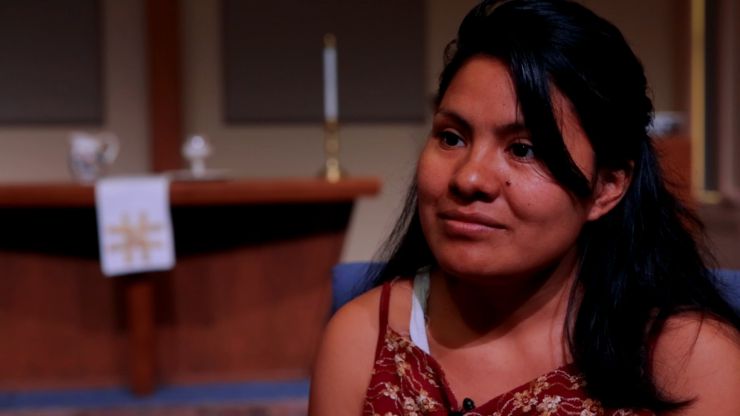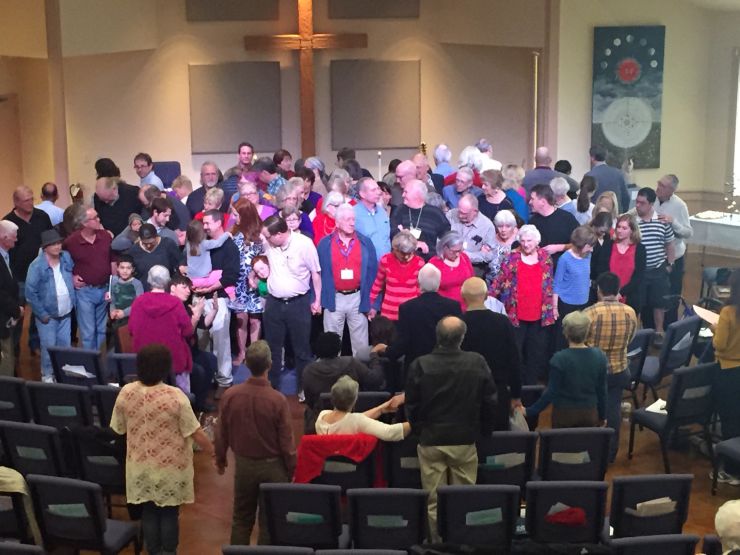Written by: Casey Tolan
Originally posted here: http://fusion.net/story/295939/hilda-ramirez-sanctuary-church-austin-immigrant-guatemala/
AUSTIN—Hilda Ramirez spends all day, every day, inside St. Andrews Presbyterian Church. She walks its linoleum-tiled hallways, reads and assembles jigsaw puzzles, and sits in on Sunday services held in a language she doesn’t understand.
If she steps outside these walls, she could be detained and deported.
For the last three months, Ramirez and her 10-year-old son Ivan, refugees from Guatemala, have been living in a room in the church to escape deportation. They’re part of a larger movement around the country that helps Central American refugees and undocumented immigrants take refuge in churches, where Immigrations and Customs Enforcement officials generally do not go.
The mother and son left San Marcos, Guatemala, two years ago, fleeing domestic violence. After crossing into the U.S., they spent 11 months in a detention center in south Texas before being granted supervised release. They took sanctuary in St. Andrews, a small church in north Austin, after officials started raiding neighborhoods around the country to deport Central American migrants earlier this year.

The two live in a former office and classroom converted into a tiny dormitory. Ramirez, a short woman with a bright smile, gave me a tour of their living quarters a couple weeks ago. “It’s a disaster,” she said, laughing, although it was actually quite clean, other than the half-solved jigsaw puzzle of an ocean scattered on a table. Hilda and Ivan sleep in bunk beds, him on top with almost a dozen stuffed animals. On the wall is a ripped portrait of Ivan—the only souvenir Ramirez still has from Guatemala.
As a policy, ICE generally does not arrest immigrants in places of worship and other “sensitive locations” such as schools and hospitals. According to a memorandum released in 2011, arrests or searches are only allowed at sensitive locations if there is “immediate need for enforcement action,” such as a dangerous felon on the run.
In the last two years, churches around the country have taken advantage of this policy to shelter undocumented immigrants and Central American refugees who face deportation. The Sanctuary Movement, a network of advocacy groups, has organized 13 churches to accept 16 immigrants since May 2014. It’s a grassroots response to soaring deportation numbers under President Obama, who has deported more immigrants than any other president .

The idea of churches as places of sanctuary goes back to 11th century Europe, where a so-called “Truce of God” gave fleeing criminals legal protection as long as they stayed in churches. In the 1980s, an earlier wave of Central American refugees were also given sanctuary in U.S. churches.
Hilda, 28, and Ivan fled Guatemala two years ago. Her husband’s parents would viciously hit her, she said, and she faced discrimination as an indigenous woman. “Life in Guatemala is a little sad for people like us,” she said in Spanish. “In my town, there wasn’t a law for a woman who has been mistreated or beaten, and I couldn’t tell anyone I was being beaten.”

The two entered the U.S. in August 2014, crossing the Rio Grande on an inflatable raft carrying 10 people. She remembers that almost immediately, helicopters were flying around them. The mother and son were detained by immigration police and immediately transferred to the Karnes County Detention Center, southeast of San Antonio.
They were placed in cells that were so cold it felt “almost like a refrigerator,” she said. Mothers and children lived together in a big space, and she said they never got enough food or medical attention.
“I thought that they were going to help me and my son,” she said. “I’m not a criminal.”
Ivan was often sick, vomiting and suffering from nosebleeds. “Sometimes in the food, in the beans, we found little bugs that were the same color as the beans,” he remembered in Spanish. “We were very hungry.”
While in detention, Ramirez applied for asylum for her and her son, citing the domestic violence she faced. But language was a big barrier. Ramirez, who is a member of the indigenous Mam group and grew up speaking Mam, said her parents never allowed her to go to school in Guatemala. She didn’t even speak much Spanish until she got to the U.S., although after 11 months in detention, she’s near-fluent.
At first, the hearing on Ramirez’s asylum claim was held in English with a Spanish interpreter, which wasn’t helpful to her at the time. Later, officials found her a Mam interpreter—but they spoke the wrong version of the language, which has nine different dialects.
Finally, after 11 months, ICE let them out on supervised release. An ICE spokesperson said that Ramirez’s asylum application was denied and a final appeal was dismissed on April 30 last year, but that she was released from detention in July as her son’s appeal progressed through the courts. She still has an ankle monitor, so ICE knows exactly where she is.

After they were released, the family spent several months in a shelter in Austin for homeless immigrants. But when immigration officials announced in late December that Central American migrants who had been ordered to leave by a judge would be detained and deported in a series of raids, Ramirez got worried. “I was really scared that the immigration police would come and knock on the door and enter, and take me,” she said. “I didn’t want to go.”
Activists helped her and her son take refuge at St. Andrews, a low-hanging church in the suburban north of the city with a tidy tiled steeple. Her lawyer has told her that staying inside will keep her safe from deportation—but ICE hasn’t always followed its “sensitive locations” policy. In February, officials lured an undocumented immigrant out of a Chicago church by sending him texts that purported to be from his cousin.
Jim Rigby, the pastor of St. Andrews, said it was an easy decision for him to take Hilda and Ivan in. While his congregation isn’t majority Latino or immigrant, he said he thought religious institutions had a responsibility to fight for social justice even outside their immediate communities.
“I would hope anyone that called themselves a person of faith would realize that we have an obligation that transcends laws,” he said. “If religion stops at the border, then it’s useless.”
After a service a few weeks ago, the congregation practiced what they would do if ICE agents showed up at the church. The churchgoers came up and encircled Hilda and Ivan, creating a mass human shield. Others locked arms in front of the front doors. “Basically the whole church came forward,” Rigby said.
The congregation cooks food for their guests, stacking tupperware containers in Ramirez’s room. They also donate clothing, medicine, and other gifts, like a tablet they gave Ivan on his tenth birthday earlier last month. “I like living here,” he said with a smile as he swiped through some apps.
Ivan, who’s in second grade, goes to a bilingual school where he’s learning English and Spanish. (A lawyer has told them that it’s OK if he leaves the church to go to school, but has to go directly to and from—so no soccer practice.)
While Ramirez says her life now is far better than their time in detention, she still wants to leave. The only place she can safely go outside is a sad, faded little jungle gym next to the church, surrounded by a chain-link fence. Cars zoom by loudly on a wide road nearby. “I was locked up, and now I’m locked up again,” she said. “Even though it’s different, it feels the same.”
She’s hoping that ICE will grant her a stay of removal—a document guaranteeing that she won’t be deported. Until then, she and Ivan will stay within the walls of the church.
“All we want is a better future for our kids,” Ramirez said of herself and her fellow Central American migrants. “We don’t come here to hurt this country. They don’t have to deport anybody.”
--
≫ Follow along LIVE from Guatemala and browse more of our fair trade products on Instagram (@hiptipico).
♡ See our female founder's daily posts featuring other ethical fashion brands and collaborations (@alyssaya).
≫ Be sure to like Hiptipico on Facebook for global news, travel and women's empowerment.








